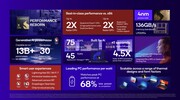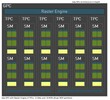NVIDIA GeForce RTX 3060 Max-Q vs Qualcomm SD X Adreno X1-85 4.6 TFLOPS vs NVIDIA GeForce RTX 3050 A Laptop GPU
NVIDIA GeForce RTX 3060 Max-Q
► remove from comparison
Die Nvidia GeForce RTX 3060 Max-Q (für Laptops, GN20-E3) bezeichnet eine GeForce RTX 3060 Laptop GPU mit Max-Q Technologien. Früher waren die Max-Q-Varianten die Stromsparversionen, mit der RTX 3000 Serie kann jedoch jede TGP-Variante mit Max-Q Technologien ausgestattet werden.
Qualcomm SD X Adreno X1-85 4.6 TFLOPS
► remove from comparison
Qualcomm Snapdragon X Adreno X1-85 (4.6 TFLOPS) ist die stärkste GPU in the Snapdragon X Elite SoCs mit 4,6 TFLOPS an Leistung. Die GPU nutzt 1.536 Unified Shader und taktet diese mit bis zu 1.500 MHz.
Durch aktuell eingeschränkten Treibersupport und Spieleunterstüztung ist die 3D-Leistung und Kompabilität in Spielen jedoch nicht vergleichbar mit Nvidia und AMD iGPUs.
Die Architektur is laut Chips and Cheese vergleichbar mit der alten Adreno 730. Daher ist die GPU DirectX 12 kompatibel, aber unterstützt nicht alle "Ultimate" Features.
Die iGPU ist im Snapdragon X SoC integriert und wird daher wie dieser in dem modernen 4nm Prozess bei TSMC gefertigt.
NVIDIA GeForce RTX 3050 A Laptop GPU
► remove from comparison
Die Nvidia GeForce RTX 3050 A Laptop GPU (oder Mobile) ist eine neue Variante basierend auf die aktuelle Ada Lovelace Architektur (im Vergleich zu Ampere bei den anderen RTX 3050 Laptop GPUs). Sie nutzt den AD106 Chip der RTX 4060 oder AD107 der RTX 4050, jedoch mit deutlich verringerter Kernanzahl und Speicherbus. Die RTX 3050 A bietet nur 1.792 GPU Kerne (CUDA Cores) und ein 4GB GDDR6 Grafikspeicher der nur mit 64-Bit angebunden ist. Nach aktuellen Informationen ist die 3050 A zum Launch nur für den Indischen Markt gedacht.
Durch die geringe Kernanzahl und den kleinen Speicherbus, sollte die Performance nicht deutlich überhalb der alten RTX 3050 4GB Laptop GPU liegen.
Der AD106 Chip wird bei TSMC im 5nm (4N) Verfahren gefertigt und ist dadurch deutlich effizienter als der alte Ampere Chip der RTX 3050 4GB. Der TGP kann vom Notebookhersteller zwischen 35 und 50 Watt gewählt werden (System Power).
| NVIDIA GeForce RTX 3060 Max-Q | Qualcomm SD X Adreno X1-85 4.6 TFLOPS | NVIDIA GeForce RTX 3050 A Laptop GPU | |||||||||||||||||||||||||||||||||||||||||||||||||||||||||||||||||||||||||||||||||||||||||||||||||||||||||||||||||||||||||||||||||||||||||||||||||
| GeForce RTX 3000 Serie |
|
|
| ||||||||||||||||||||||||||||||||||||||||||||||||||||||||||||||||||||||||||||||||||||||||||||||||||||||||||||||||||||||||||||||||||||||||||||||||
| Codename | GN20-E3 GA106 | ||||||||||||||||||||||||||||||||||||||||||||||||||||||||||||||||||||||||||||||||||||||||||||||||||||||||||||||||||||||||||||||||||||||||||||||||||
| Architektur | Ampere | Ada Lovelace | |||||||||||||||||||||||||||||||||||||||||||||||||||||||||||||||||||||||||||||||||||||||||||||||||||||||||||||||||||||||||||||||||||||||||||||||||
| Pipelines | 3840 - unified | 1536 - unified | 1792 - unified | ||||||||||||||||||||||||||||||||||||||||||||||||||||||||||||||||||||||||||||||||||||||||||||||||||||||||||||||||||||||||||||||||||||||||||||||||
| Kerntakt | 1283 (Boost) MHz | 1500 (Boost) MHz | |||||||||||||||||||||||||||||||||||||||||||||||||||||||||||||||||||||||||||||||||||||||||||||||||||||||||||||||||||||||||||||||||||||||||||||||||
| Speicherbandbreite | 192 Bit | 64 Bit | |||||||||||||||||||||||||||||||||||||||||||||||||||||||||||||||||||||||||||||||||||||||||||||||||||||||||||||||||||||||||||||||||||||||||||||||||
| Speichertyp | GDDR6 | LPDDR5x | GDDR6 | ||||||||||||||||||||||||||||||||||||||||||||||||||||||||||||||||||||||||||||||||||||||||||||||||||||||||||||||||||||||||||||||||||||||||||||||||
| Max. Speichergröße | 6 GB | 4 GB | |||||||||||||||||||||||||||||||||||||||||||||||||||||||||||||||||||||||||||||||||||||||||||||||||||||||||||||||||||||||||||||||||||||||||||||||||
| Shared Memory | nein | ja | nein | ||||||||||||||||||||||||||||||||||||||||||||||||||||||||||||||||||||||||||||||||||||||||||||||||||||||||||||||||||||||||||||||||||||||||||||||||
| API | DirectX 12_2, Shader 6.7, OpenGL 4.6 | DirectX 12_1, OpenGL ES 3.2, OpenCL 3.0, Vulkan 1.3 | DirectX 12_2, Shader 6.7, OpenGL 4.6 | ||||||||||||||||||||||||||||||||||||||||||||||||||||||||||||||||||||||||||||||||||||||||||||||||||||||||||||||||||||||||||||||||||||||||||||||||
| Stromverbrauch | 60 Watt | 40 Watt | 45 Watt (35 - 80 Watt TGP) | ||||||||||||||||||||||||||||||||||||||||||||||||||||||||||||||||||||||||||||||||||||||||||||||||||||||||||||||||||||||||||||||||||||||||||||||||
| Herstellungsprozess | 8 nm | 4 nm | 5 nm | ||||||||||||||||||||||||||||||||||||||||||||||||||||||||||||||||||||||||||||||||||||||||||||||||||||||||||||||||||||||||||||||||||||||||||||||||
| Notebookgröße | groß (17" z.B.) | mittel (15.4" z.B.) | |||||||||||||||||||||||||||||||||||||||||||||||||||||||||||||||||||||||||||||||||||||||||||||||||||||||||||||||||||||||||||||||||||||||||||||||||
| Erscheinungsdatum | 04.01.2021 | 26.10.2023 | 26.07.2024 | ||||||||||||||||||||||||||||||||||||||||||||||||||||||||||||||||||||||||||||||||||||||||||||||||||||||||||||||||||||||||||||||||||||||||||||||||
| Speichertakt | 8448 MHz | ||||||||||||||||||||||||||||||||||||||||||||||||||||||||||||||||||||||||||||||||||||||||||||||||||||||||||||||||||||||||||||||||||||||||||||||||||
| Displays | 3 Displays (max.) | HDMI 2.1, DisplayPort 1.4a | |||||||||||||||||||||||||||||||||||||||||||||||||||||||||||||||||||||||||||||||||||||||||||||||||||||||||||||||||||||||||||||||||||||||||||||||||
| Features | SUHD 2160p60 resolution support, AVC/HEVC/AV1 encoding and decoding | NVIDIA DLSS, NVIDIA Reflex, Resizable BAR, NVIDIA Broadcast, NVIDIA Ansel, NVIDIA ShadowPlay, NVIDIA G-SYNC, Advanced Optimus, Nvidia Max-Q, Dynamic Boost | |||||||||||||||||||||||||||||||||||||||||||||||||||||||||||||||||||||||||||||||||||||||||||||||||||||||||||||||||||||||||||||||||||||||||||||||||
| PCIe | 4.0 | ||||||||||||||||||||||||||||||||||||||||||||||||||||||||||||||||||||||||||||||||||||||||||||||||||||||||||||||||||||||||||||||||||||||||||||||||||
| Predecessor | GeForce RTX 3050 4GB Laptop GPU |
| ||||||||||||||||||
Benchmarks
3DM Vant. Perf. total + Qualcomm SD X Adreno X1-85 4.6 TFLOPS
Cinebench R15 OpenGL 64 Bit + Qualcomm SD X Adreno X1-85 4.6 TFLOPS
Average Benchmarks Qualcomm SD X Adreno X1-85 4.6 TFLOPS → 0% n=0
* Smaller numbers mean a higher performance
1 This benchmark is not used for the average calculation
Spiele-Benchmarks
Die folgenden Benchmarks basieren auf unseren Spieletests mit Testnotebooks. Die Performance dieser Grafikkarte bei den gelisteten Spielen ist abhängig von der verwendeten CPU, Speicherausstattung, Treiber und auch Betriebssystem. Dadurch müssen die untenstehenden Werte nicht repräsentativ sein. Detaillierte Informationen über das verwendete System sehen Sie nach einem Klick auf den fps-Wert.

Total War Pharaoh
2023
Baldur's Gate 3
2023
F1 22
2022
Far Cry 5
2018
X-Plane 11.11
2018
Dota 2 Reborn
2015
The Witcher 3
2015
GTA V
2015| Qualcomm SD X Adreno X1-85 4.6 TFLOPS | low | med. | high | ultra | QHD | 4K |
|---|---|---|---|---|---|---|
| Total War Pharaoh | 91.1 | 63.6 | ||||
| Cyberpunk 2077 2.1 Phantom Liberty | 23.1 | 21.8 | 18.8 | 16.6 | ||
| Baldur's Gate 3 | 27 | 22 | 19.3 | 19 | ||
| F1 22 | 65.9 | 60 | 43.3 | 32 | ||
| Shadow of the Tomb Raider | 66 | 28 | 26 | 23 | ||
| Strange Brigade | 143 | 56 | 48 | 41 | ||
| Far Cry 5 | 37 | 31 | 30 | 27 | ||
| X-Plane 11.11 | 36.2 | |||||
| Final Fantasy XV Benchmark | 56.8 | 27.8 | 17.8 | |||
| Dota 2 Reborn | 88.2 | 68.8 | 61 | 52.8 | ||
| The Witcher 3 | 107 | 73 | 41 | 22 | ||
| GTA V | 103 | 95.4 | 49.5 | 22.4 | ||
| < 30 fps < 60 fps < 120 fps ≥ 120 fps | 2 3 6 1 | 4 2 5 | 4 5 1 | 6 3 | | |
Eine Liste mit weiteren Spielen und allen Grafikkarten finden Sie auf unserer Seite: Welches Spiel ist mit welcher Grafikkarte spielbar?















